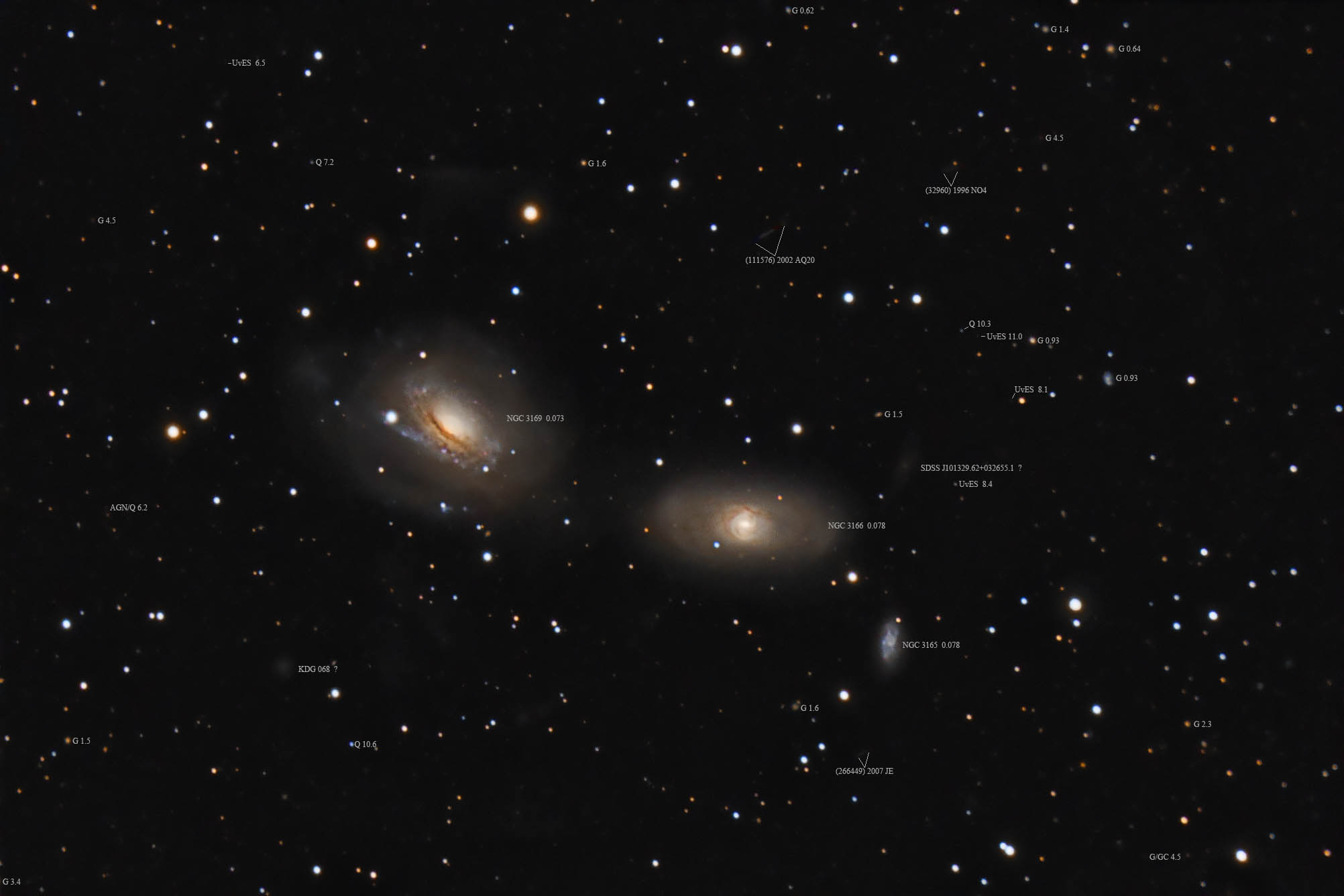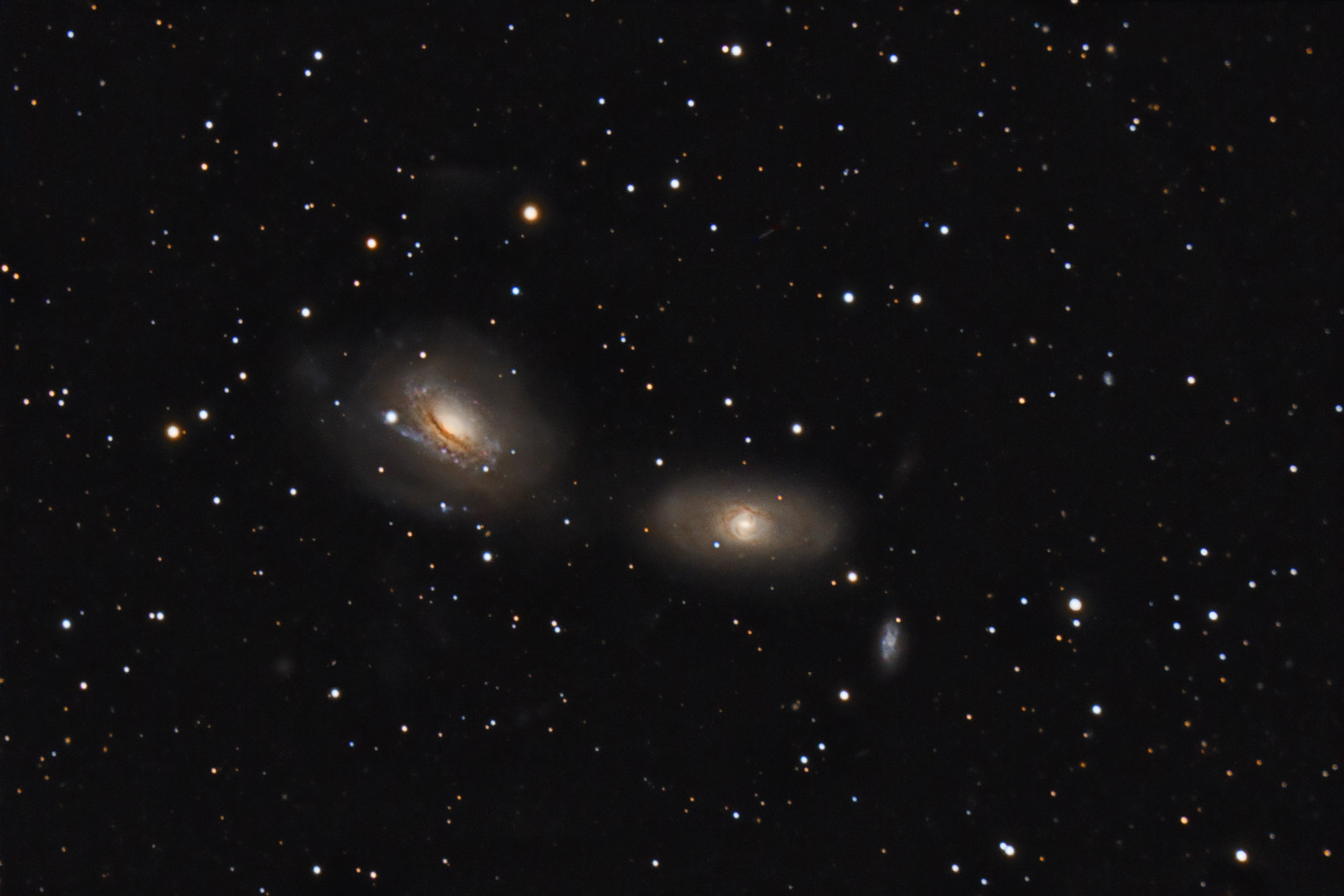| Description | Images |
Object name: NGC3166Designation(s): NGC3166, NGC3165, NGC3169, NGC 3166 and 3169 are a pair of interacting galaxies Arp somehow missed. Third NGC galaxy is NGC 3165. All three are at the same redshift distance with any differences being within measurement error and relative velocity as they encounter each other. All three appear distorted with NGC 2169 on the east side being really tore up with tidal clouds and plumes everywhere. Some images indicate a curving plume from 3166 going southeast then back northeast to 3169. It is broken, not continuous in my image. Likely due to my very short exposure time. A much broader connection seems to go directly east/west between the two so it is hard to tell where one ends and the other begins. With all the debris from their interaction, I don't understand way Arp didn't include this one in his atlas of peculiar galaxies. They are located in Sextans about 73 to 78 million light-years away. If this is correct these are two very large galaxies. NGC 3166 would be about 120 thousand light-years across. NGC 3169 would be 145 thousand light-years across. "Little" NGC 3165 would be 33 thousand light-years in diameter. Related Designation(s):1RXS J101414.8+032803, 2MASS J10134567+0325292, 2MASS J10141504+0327580, 2MASX J10134567+0325288, 2MASX J10141509+0327580, 87GB 101138.5+034211, 87GB[BWE91] 1011+0342, AKARI J1013457+032533, AKARI J1014151+032752, ASK 095846.0, ASK 095850.0, CGCG 036-063, CGCG 036-064, CGCG 036-066, CGCG 1010.9+0338, CGCG 1011.1+0340, CGCG 1011.7+0343, CXO J101415.05+032758.0, GALEXASC J101345.53+032530.1 , GALEXMSC J101345.52+032529.3 , GB6 J1014+0327, HDCE 0569 NED002, HDCE 0569 NED003, HIPASS J1014+03, HIPEQ J1014+03, HIR J1014+0329, HOLM 173A, HOLM 173B, HOLM 173C, IRAS 10111+0340, IRAS 10116+0342, IRAS F10111+0340, IRAS F10116+0342, ISOSS J10137+0325, KPG 228A, KPG 228B, LDCE 0715 NED002, LDCE 0715 NED003, LGG 192:[G93] 002, LGG 192:[G93] 003, LGG 192:[G93] 004, LQAC 153+003 021, MCG +01-26-023, MCG +01-26-024, MCG +01-26-026, NFGS 052, NGC 3165, NGC 3166, NGC 3169, NGC 3169:[ECB2002] C, NGC 3169:[L2011a] X0001, NGC3165, NGC3166, NGC3169, NSA 136847, NSA 157994, NSA 158036, NVSS J101415+032757, PGC 029798, PGC 029814, PGC 029855, PMN J1014+0327, SDSS J101331.29+032230.0, SDSS J101331.30+032230.0, SDSS J101331.30+032230.1, SDSS J101345.77+032529.8, SDSS J101345.78+032529.9, SDSS J101345.80+032529.9, SDSS J101414.21+032802.6, SDSS J101415.04+032758.0, SSTSL2 J101345.66+032529.2, SSTSL2 J101414.99+032757.3, UGC 05512, UGC 05516, UGC 05525, USGC U286 NED02, USGC U286 NED03, USGC U286 NED04, UZC J101331.3+032233, UZC J101345.6+032532, UZC J101414.8+032800, WVFS J1013+0330, WVFSCC J101411+032820, [AHG2014] B145, [AHG2014] B146, [M98j] 082 NED02, [M98j] 082 NED03, [M98j] 082 NED04, [RHM2006] SFGs 022, [RHM2006] SFGs 056, [SLK2004] 0578, [VCV2001] J101414.8+032759, [VCV2006] J101414.8+032759, |

